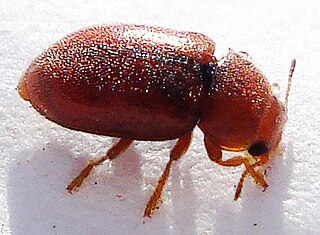
Coccidula is a genus of lady beetles in the family Coccinellidae. There are five species described in Coccidula.

Dryophilinae is a subfamily of death-watch and spider beetles in the family Ptinidae. There are at least six genera and two described species in Dryophilinae.

Aegialiinae is a small subfamily of the family Scarabaeidae. Historically the group has been treated as a tribe within a broad definition of the subfamily Aphodiinae.

Agabinae is a subfamily of predaceous diving beetles in the family Dytiscidae. There are about 11 genera and more than 460 described species in Agabinae.
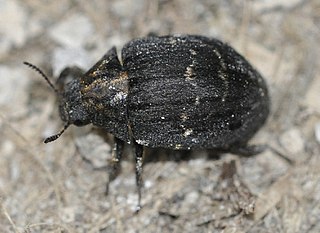
Byrrhinae is a subfamily of pill beetles in the family Byrrhidae. There are about 25 genera and at least 160 described species in Byrrhinae.

Cryptophagini is a tribe of silken fungus beetles in the family Cryptophagidae. There are about 8 genera and at least 60 described species in Cryptophagini.
Trachelizinae is a subfamily of primitive weevils in the family of beetles known as Brentidae. There are at least 110 genera and 710 described species in Trachelizinae.

Xenoscelinae is a subfamily of pleasing fungus beetles in the family Erotylidae. There are about 8 genera and 12 described species in Xenoscelinae.

Cryptarchinae is a subfamily of sap-feeding beetles in the family Nitidulidae. There are at least 3 genera and about 17 described species in Cryptarchinae.

Apioninae is a subfamily of pear-shaped weevils in the family of beetles known as Brentidae. There are at least 20 genera and 80 described species in Apioninae. They feed on living vegetation and sometimes on galls, making them occasional pests or tools of biological control.
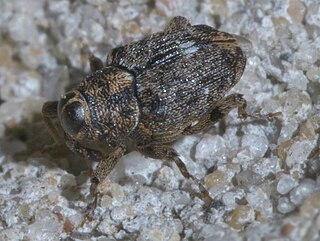
Conoderinae is a subfamily of true weevils in the beetle family Curculionidae. There are more than 210 genera in 15 tribes, and about 2,400 described species in Conoderinae.

Atomariinae is a subfamily of silken fungus beetles in the family Cryptophagidae. There are about 8 genera and more than 170 described species in Atomariinae.

Atomariini is a tribe of silken fungus beetles in the family Cryptophagidae. There are about 5 genera and at least 70 described species in Atomariini.

Phaleriini is a tribe of darkling beetles in the family Tenebrionidae. There are at least two genera and about six described species in Phaleriini.
Euphaniini is a tribe of spiny-legged rove beetles in the family Staphylinidae. There are at least 8 genera in Euphaniini.

Merophysiinae is a subfamily of handsome fungus beetles in the family Endomychidae.

Priasilphidae is a family of beetles in the superfamily Cucujoidea. They have a Gondwanan distribution, with the three known genera Chileosilpha, Priasilpha and Priastichus being native to Chile, New Zealand and Tasmania respectively. Most species are flightless, lacking wings. Priasilphids inhabit decaying wood and moss in forest habitats. They are likely mycophagous, feeding on fungi.
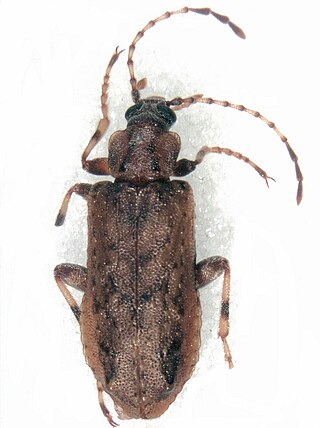
Promecheilidae is a family of beetles in the superfamily Tenebrionoidea. Perimylopidae is considered a synonym. They are found in southern South America and associated archipelagos like South Georgia and the Falklands, New Zealand and Tasmania. Some species are associated tree ferns and moss-covered dead wood, and other forested habitats, while others are associated with peat bogs, grasslands and coastal habitats. They are probably phytophagus, feeding on lichen, moss, and other plant material.
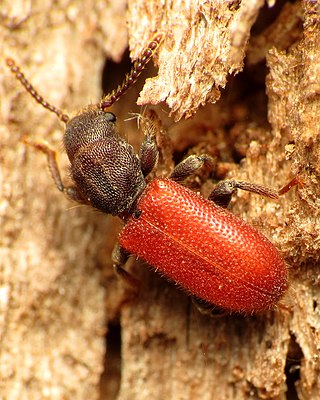
Thanerocleridae is a family of beetles belonging to the superfamily Cleroidea. It was formerly considered a subfamily of Cleridae, but was recently elevated to the rank of family. The family has 36 living species in 10 genera, which are found globally, mostly in low-latitude tropical regions, though the genus Zenodosus is found in temperate North America. Thaneroclerid species are likely all predatory both in adult and larval stages. They target small fungus and wood associated beetles, and are generally found in places where such beetles are likely to be found, typically tree associated habitats such as under bark, though some species occur in other locations such as termite nests.

Lachnogyini is a tribe of darkling beetles in the subfamily Pimeliinae of the family Tenebrionidae. There are at least three genera in Lachnogyini.


















